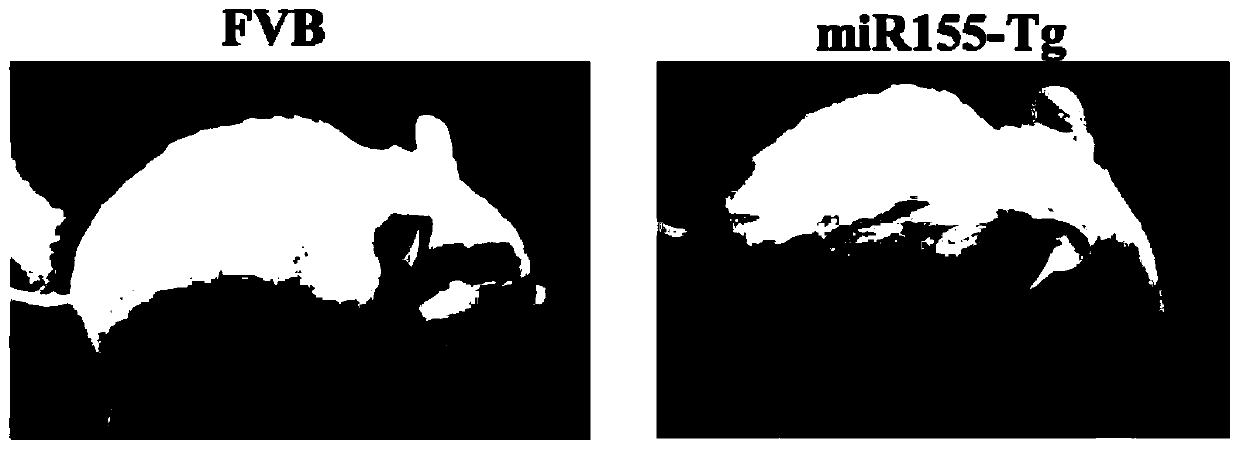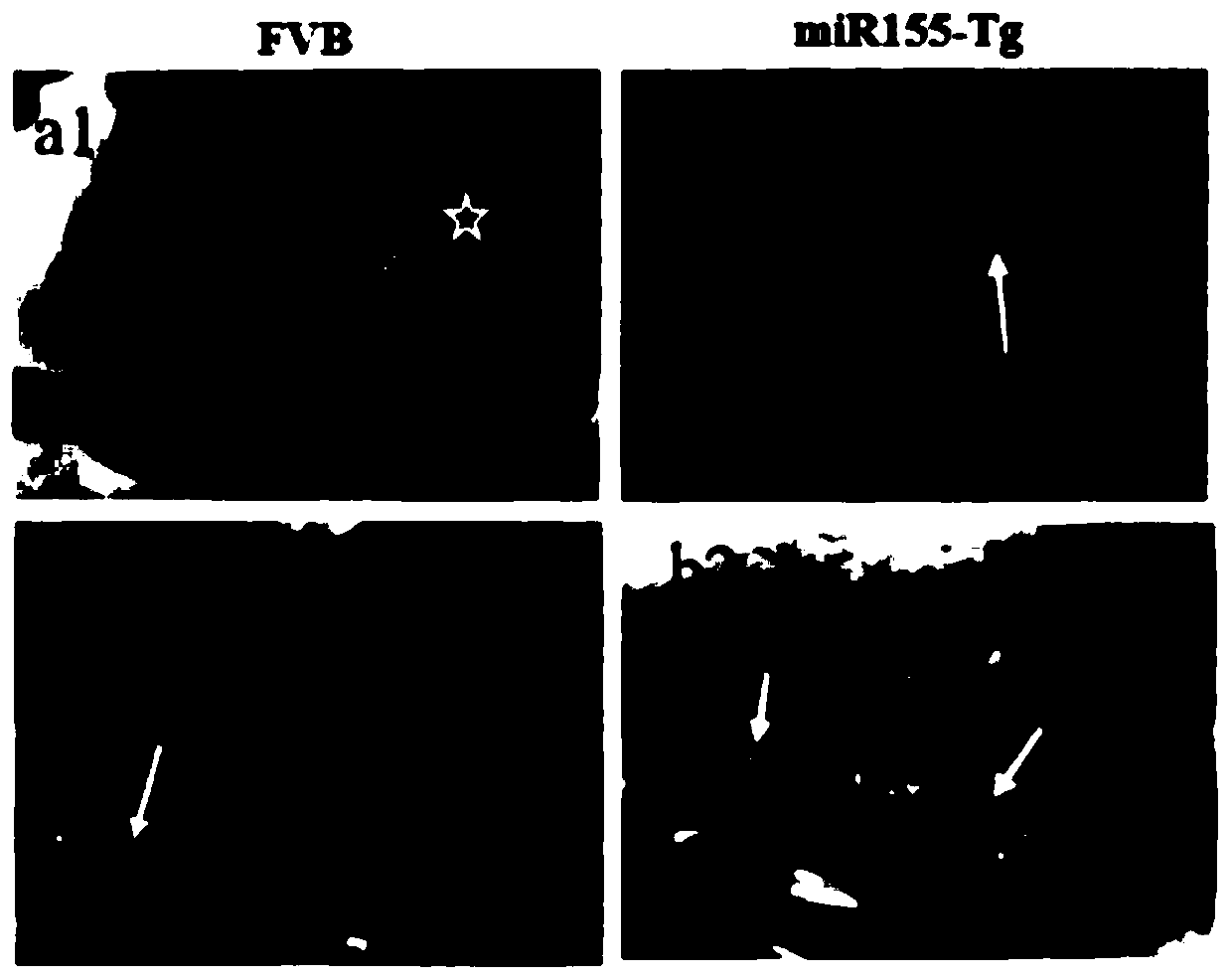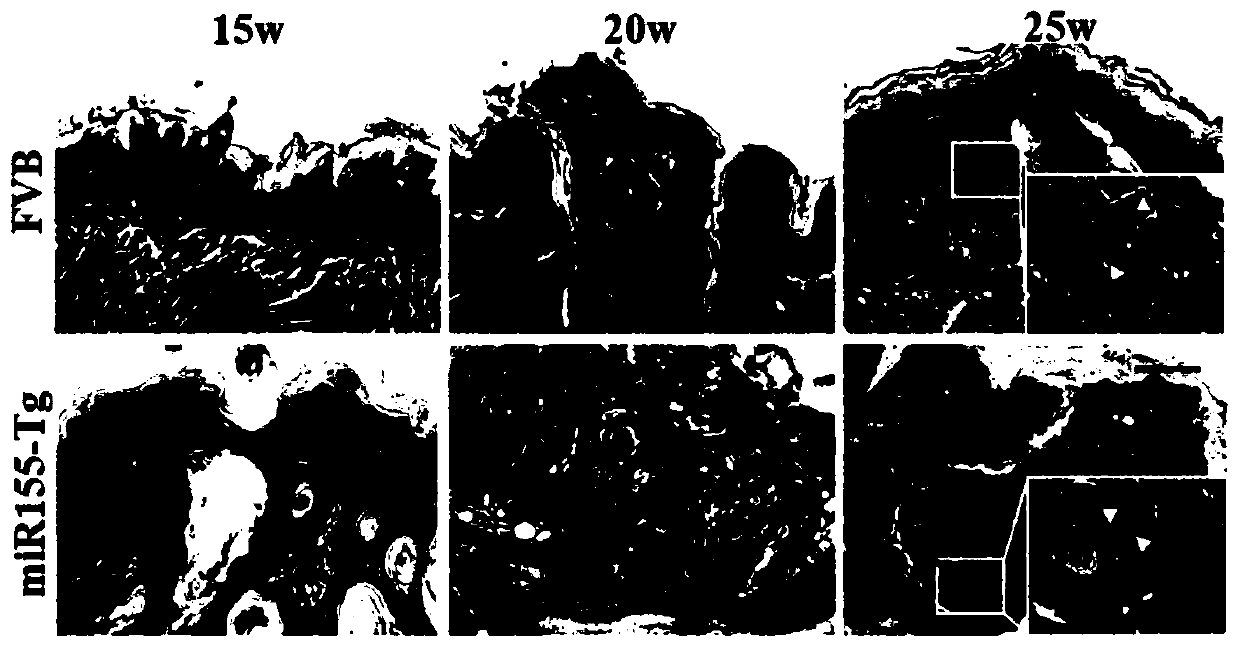Construction method of miR155 overexpression mouse tongue squamous cell cancer model
A tongue squamous cell carcinoma, construction method technology, applied in the field of construction of miR155 overexpression mouse tongue squamous cell carcinoma model, can solve the problems of human TSCC etiology and pathogenesis gap, individual differences, long induction time and other problems, Achieve good promotion and application value, stable characterization, and good repeatability
- Summary
- Abstract
- Description
- Claims
- Application Information
AI Technical Summary
Problems solved by technology
Method used
Image
Examples
Embodiment 1
[0036] Example 1 Construction of tongue squamous cell carcinoma model in mice with miR155 overexpression
[0037] A method for constructing a miR155 overexpression mouse tongue squamous cell carcinoma model, comprising the following steps:
[0038] (1) Verification of miR155 transgenic mice and FVB mice
[0039] The miR155 transgenic mice were mass-produced in the form of mREF positive × mREF positive or mREF positive × mREF negative, and the postnatal transgenic mice were detected with a small animal imager for REF signals to identify miR155 transgenic mice (positive REF signals) or FVB Mice (litmate control, negative REF signal); detection of Luc signal distribution in the whole body of miR155 transgenic mice to confirm the overexpression of miR-155 gene in the tongue of miR155 transgenic mice.
[0040](2) 4NQO induction treatment
[0041] 1) Preparation of reagents
[0042] Preparation of reagent A: first dissolve 4-nitroquinoline-1-oxide (4-nitroquinoline-oxide, 4NQO) i...
Embodiment 2
[0054] Example 2 General Morphological Observation of miR155 Transgenic Mice
[0055] 1. Experimental method
[0056] During the process of raising mice in step (3) in Example 1, observe the mental state, exercise status, diet, water intake, body weight, coat color and excretion of the mice every day, and record the water intake and body weight of the mice every week , and check the changes in the oral cavity of the mice, record the color and texture of the oral mucosa of the mice including the back of the tongue, the belly of the tongue, and the floor of the mouth, and observe whether there are plaques, ulcers or tumors.
[0057] 2. Experimental results
[0058] The results of the morphological characteristics of the mice in the experimental group and the control group until the 10th week were as follows: figure 1 As shown, it can be seen that when the 4NQO solution was fed to the 10th week, it was found that the mice in the experimental group 1 and the experimental group ...
Embodiment 3
[0061] Example 3 Analysis of TSCC process in miR155 transgenic mice
[0062] 1. Experimental method
[0063] After the experimental group and control group mice constructed in Example 1 were put to death, if the mouse tongue was confirmed to have precancerous lesions or tumors, then measure the size of the tongue lesions, tongue tumor number, weight, length (L), width (W), calculate tumor volume, carry out TSCC process analysis;
[0064] The formula for calculating tumor volume is as follows: V=L×W 2 ×0.5.
[0065] 2. Experimental results
[0066] The scoring criteria for the analysis of TSCC progress in mice are shown in Table 1, which can clearly and intuitively represent the progress of TSCC in mice.
[0067] Table 1 Scoring criteria for mouse TSCC process analysis
[0068]
[0069] The number of tumors in the tongue of mice in the experimental group was as follows: Figure 4 As shown in Figure a, it can be seen that the number of tongue tumors in miR155 transgenic...
PUM
| Property | Measurement | Unit |
|---|---|---|
| Concentration | aaaaa | aaaaa |
| Concentration | aaaaa | aaaaa |
Abstract
Description
Claims
Application Information
 Login to View More
Login to View More - Generate Ideas
- Intellectual Property
- Life Sciences
- Materials
- Tech Scout
- Unparalleled Data Quality
- Higher Quality Content
- 60% Fewer Hallucinations
Browse by: Latest US Patents, China's latest patents, Technical Efficacy Thesaurus, Application Domain, Technology Topic, Popular Technical Reports.
© 2025 PatSnap. All rights reserved.Legal|Privacy policy|Modern Slavery Act Transparency Statement|Sitemap|About US| Contact US: help@patsnap.com



